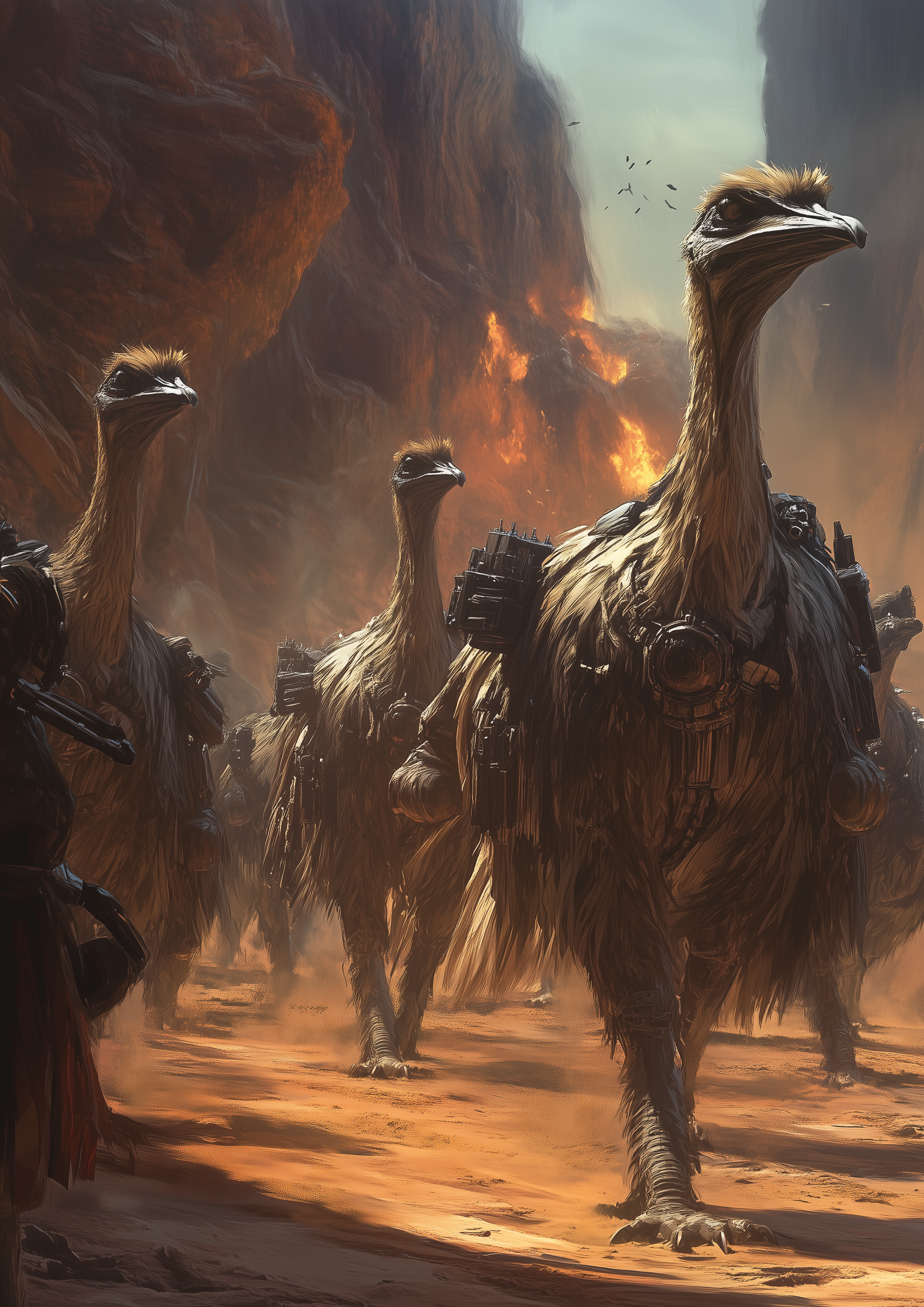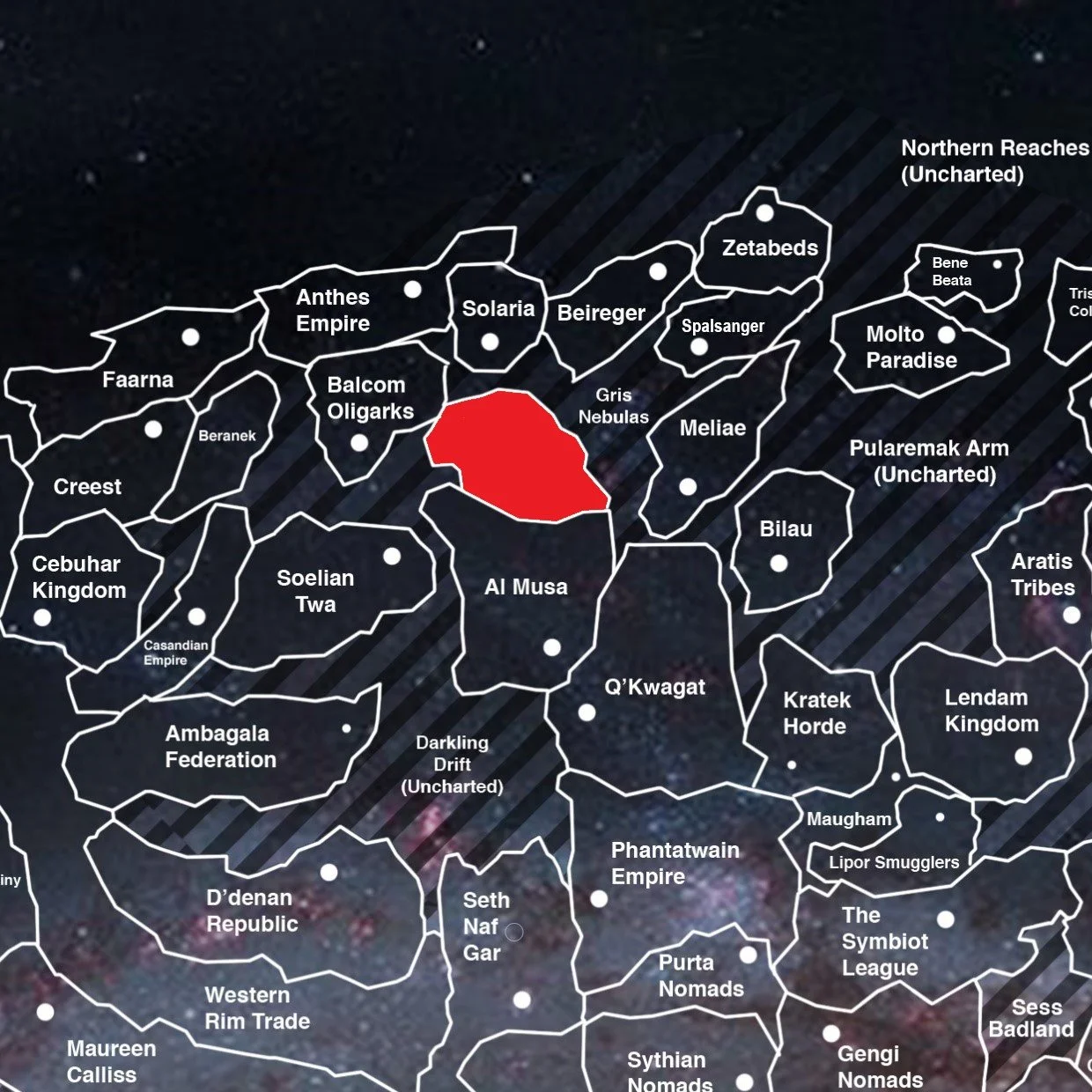Aarat Confederacy
Uplifted Avian Civilization
Overview
The Aarat, known to the ancients as the Feathered Lords of Aaratus, were a marvel of uplifted evolution, a species that spanned the skies and the seas with equal grace. Native to the island world of Aaratus, their origins were intimately tied to the intervention of the Borthan, a species known for sculpting potential life into powerhouses of intelligence and capability. Standing at eight feet, their towering forms were wrapped in plumage that ranged from iridescent silver to deep azure, with subtle color variations marking age, status, and even emotional state. Their wings, capable of both flight and dexterous manipulation, retracted elegantly to reveal three-fingered hands — tools that carved civilization from sea cliffs and airborne citadels.
The Aarat’s matriarchal society reflected the natural order of their world, where female Formels led with a combination of wisdom and ruthless pragmatism. In contrast, crested males, though vibrant and clever, found themselves relegated to secondary roles — advisors, artisans, warriors — but never rulers. This gendered dynamic became a defining trait of Aarat governance and military structure, blending reverence and resentment into a fragile equilibrium.
Aaratus itself was a planet of splintered land and endless water, forcing the Aarat to master both sky and sea. The planet’s helium-rich atmosphere — thin even by Estra standards — gifted them with lighter-than-expected bones and incredible endurance in low-gravity environments. This very environment, however, deprived them of certain metals, shaping a culture where innovation was not just celebrated — it was survival.
The first interstellar records of the Aarat date back to 2465, when the Western Rim Company stumbled upon them at Rimater 4. Trade agreements flourished, and soon, the Aarat’s soaring ships could be seen above a dozen worlds. Yet, as with so many empires, their downfall was the result of the Cyber Rebellion. The Aarat Confederacy came to an end in 3820, when the last starsystem fell to a combined invasion force of Geddan, and Charon cybers supported by a Balcom Oligarch fleet.
Civil Structure
The Aarat Confederacy was a rigidly matriarchal hierarchy, a society where power descended exclusively through maternal lines. At its apex stood the Formel Supreme, an elected female from the ruling clades, whose plumage was ritually dyed in the rarest shades of violet — a color so rare on Aaratus that only a single island’s coral produced the proper pigment. Below her, a cascading web of matriarchs governed planetary holdings, naval fleets, and even religious observances, each one tracing her authority back to a single ancestral broodmother.
Males existed in an ambiguous twilight of honor and limitation. They were celebrated for their strength, their songcraft, and their bravery in battle, yet denied the chance to rise into the hallowed halls of policy or command. This dichotomy played out in fascinating ways — husbands often served as their wives’ personal envoys, bodyguards, or even emissaries to offworld species, as male Aarat were considered more "disposable" in high-risk diplomatic ventures.
One of the most curious cultural institutions was the Skychain Council, a rotating body of elderly females who had survived at least three major wars. They served not only as historians but as "living judges," delivering legal rulings infused with the memory of every major betrayal and alliance across centuries. It was said no contract, no alliance, no war declaration was ever signed without a Skychain member inscribing her talon mark beside it — binding the document with the weight of personal memory.
A student once asked me why such a system lasted so long — why didn’t the males rebel? The answer, in the case of the Aarat, was simple: tradition is the strongest chain. Aarat sons were raised to revere their mothers, pledge themselves to sisters, and view ambition as a collective virtue rather than an individual goal. It was a society soaring on the wings of communal duty — until those wings were clipped.
Military
The Aarat military, much like their society, mirrored the duality of command and sacrifice. At the heart stood the Skybound Vanguard, an all-female officer corps whose tactical brilliance was tempered by the complete absence of frontline experience. These matriarch-commanders were trained in aerial combat doctrine, fleet logistics, and psychological warfare from adolescence, but they never drew a blade outside a training hall. Instead, the Talons — overwhelmingly male — formed the bulk of ground and boarding forces, wielding a curious mix of plasma lances and ultrasonic blades designed to shatter enemy exoskeletons.
This division created a strange vulnerability. While Aarat fleets were renowned for their clever maneuvering and innovative use of transmuted materials — their ships could literally reshape their armor mid-battle — the loss of a single command vessel often triggered cascading confusion. With female officers too precious to risk in direct combat, Aarat forces became over-reliant on fragile communication networks. During the war with the Balcom Oligarks, this Achilles' wing was exploited mercilessly — cybernetic shock troops specifically targeted female officers, leaving entire squadrons directionless.
One haunting artifact recovered from the ruins of Oaran-7 was the Last Feather Protocol, a desperate doctrine where lower-ranked males were permitted to "ascend" to command only if every female officer was confirmed dead. I still remember the inscription on that battered data-slate:
"Should no mother voice remain to guide us, let her sons speak in her name — and let the galaxy tremble at their grief."
Special Technologies
The most unique hallmark of Aarat science was their art of mineral transmutation, a technology born from necessity on resource-scarce Aaratus 6. Without natural deposits of certain rare metals, the Aarat learned to alter the atomic structures of more common materials, effectively transforming lead into something akin to titanium — or at least close enough for ship hulls. This "feathered alchemy" was far from perfect; transmuted metals were prone to molecular instability, especially under prolonged stress, but it allowed the Aarat to maintain a mobile industrial base the envy of neighboring systems.
Entire mining ships became flying foundries, capable of processing asteroids into not just raw material, but fully formed ship components, bypassing the need for vast industrial planets. This gave the Aarat fleet incredible logistical agility, able to repair or even rearm itself deep in hostile space — at least until the strain of war outpaced even their alchemic talents.
One particularly infamous incident involved the battleship Formel’s Wing, whose entire dorsal hull was transmuted mid-battle to counter a new Balcom weapon. The maneuver saved the ship — briefly — but left the crew breathing toxic off-gassing from unstable alloys, dooming them to slow suffocation. Such was the cost of innovation in a sky forever short of precious metals.
Even today, archaeologists scour the Tuaffarra Nebula, searching for lost Aarat outposts where the last of their alchemical secrets might still lie dormant — waiting for hands clever enough to unlock them once more.
Aarat Troopers on the march.
Capital system Aarat Starsystem
Largest system
Oaran Starsystem
Official
languages Arat
Common Tradespeak
Ethnic groups
Aarat
Religion Deism
Government
Matriarchy
Legislature
Formel Council
Skychain Council
Starsystems
12,445,665
Currency
Alent, Oren, Tetrak, Filo, Oku, Paprita
End Date3820





